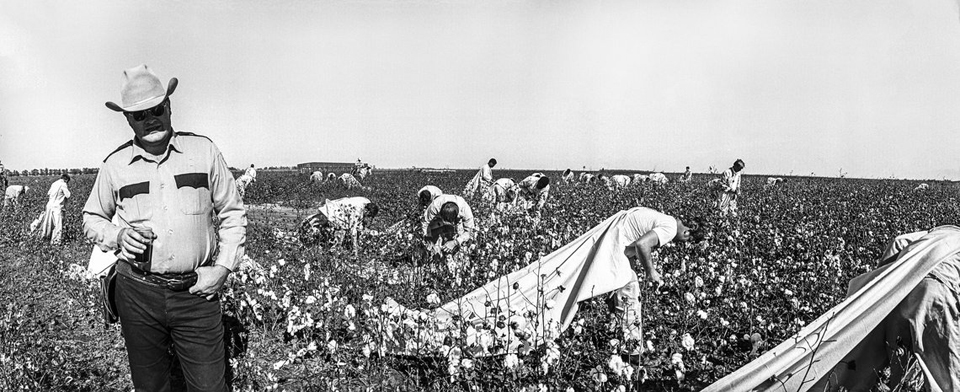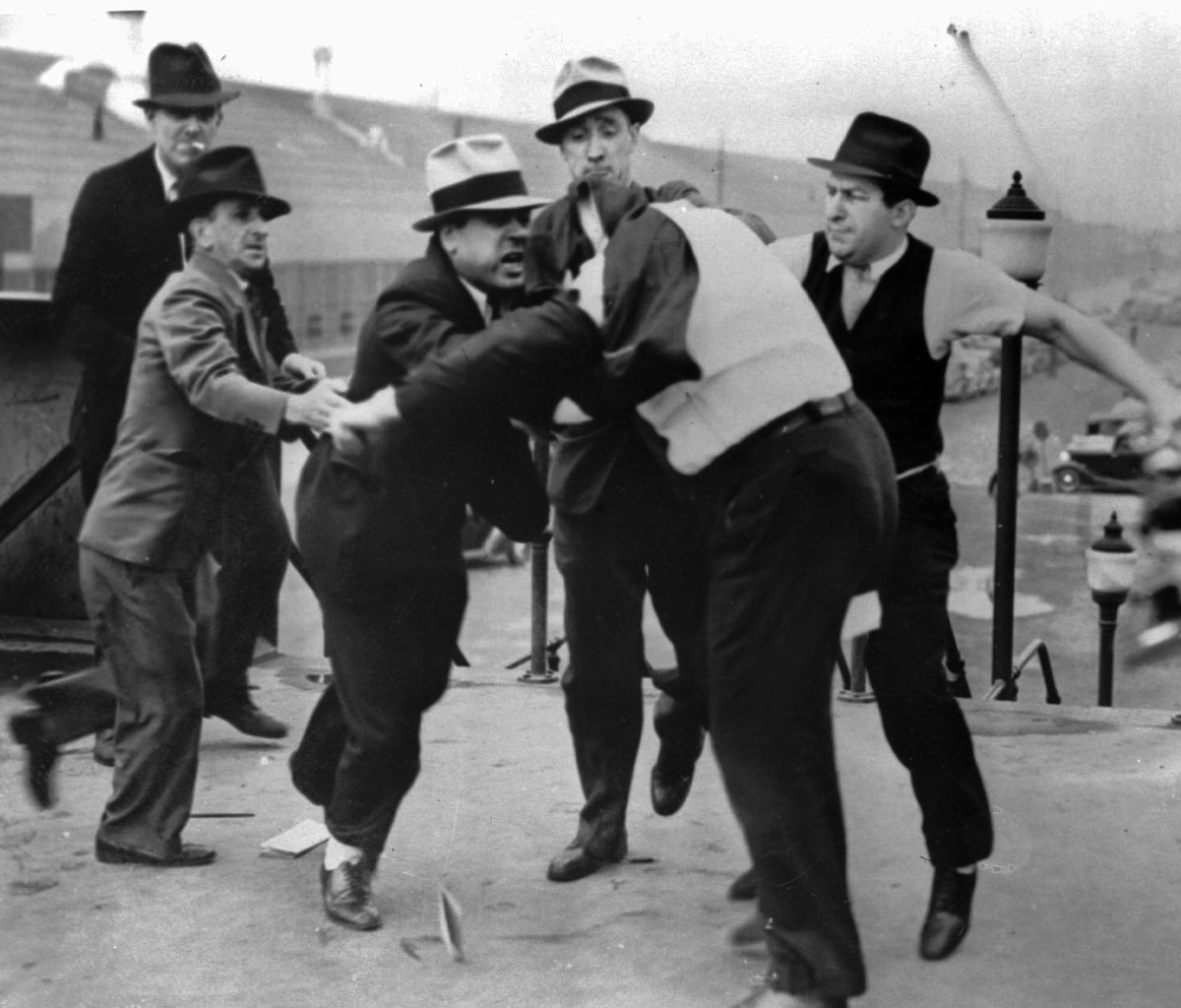This Day in Labor History: October 4, 1978. Nine Ellis Prison inmates in east Texas went on strike against the unpaid labor they had to do every day, refusing to pick cotton in hard labor. Let's talk about the endless struggle against prison slavery in this country! 

Prisoners at Ellis Prison, located twelve miles north of Huntsville, were expected to pick between 200 and 300 pounds of cotton a day. The fields were racially segregated, with black, white, and Mexican-American work crews.
Like the stereotype of an antebellum cotton plantation, a prison guard, called by the inmates the “cap’ain.” rode a horse through the fields armed with a shotgun. The Texas prison system was modeled on slavery and had largely been since the period of slavery.
The state’s prison system was notorious among criminologist as the most backward in the nation going back to at least the 1940s. Guards frequently brutalized inmates.
Earlier systems of prison work had led to a lot of white outrage, particularly the convict labor leasing system that undermined white wages and sometimes led to active resistance from competing wage workers.
Texas attempted to reform its prison system by the late 1940s by emphasizing work, not as work competing with free laborers, but as agricultural laborers. They worked the prisoners like slaves, ten hour days, at a rapid pace due to aggressive overseers.
In 1978, most of these prisoners were from cities and had no experience picking cotton, so this was especially brutal. The racial segregation made things worse. The prisons used the potential of indoor work as incentives to work the outdoor laborers even harder.
Texas was one of only seven states by the 1970s that did not pay their inmates anything for their labor.
On October 4, nine inmates decided to not work. They sat down. This action inspired other prisoners. By noon, 408 other inmates has joined them. Word of this spread like wildfire around other east Texas cotton plantation prisons.
Through the next week, the prisoners were in open rebellion. On October 10, 1500 inmates at the Canfield prison barricaded themselves inside their cells to refuse going to the fields at all. The Texas Department of Correction then stormed the building, using tear gas.
By the end of the week, six of the prison system’s fifteen units had a work stoppage, involving about 15 percent of the state’s prisoners.
Of course, this was far from the first prison action of the era. Everyone in those prisons knew about Attica and about George Jackson and what happened when a group of prisoners stood up to their exploitation. But there were a lot of actions like this taking place.
In late 1972, a lawsuit, Ruiz v. Estelle was filed that demanded Texas end the practice of having inmates serve as guards, force the prisons to end overcrowding, and grant inmates access to attorneys.
Prisons picked select prisoners to serve as convict guards, giving them guns, and leaving them in charge of the prison.
In the South, with unpaid or nearly unpaid cotton labor the usual occupation of the workers, these were invariably white prisoners lording their power over prisoners that were often majority people of color, making sure no one escaped.
The potential for violence and exploitation is obvious and was extremely common.
In Texas, it was slightly different in that the actual guards controlled prison labor while the convict guards controlled matters inside prison walls. Prisoners who resisted this system often faced violence.
When a veteran SNCC organizer turned Black Power advocate named Ernest McMillan went to prison for inciting a riot after a protest against a white-owned store in Dallas, he began organizing the prisoners.
When his group refused to work on a Sunday in 1973, the guards forced them to run a gauntlet, then stripped the prisoners, and forced them to work in the fields picking corn while still being beaten by the guards.
McMillan continued organizing and got word out to African-American state legislators in Texas, leading to an investigation.
David Ruiz himself was a nearly life-long prisoner who learned to take his rage and direct it toward the prison system and when he wrote a twelve-page petition in 1972 describing the prison system, it attracted attention, eventually leading to the 1978 lawsuit.
This case had just convened a couple of days before the Ellis prison workers’ action. One of the nine inmates from Ellis, Butch Mendez, wrote to state senator Chet Brooks to explain their actions:
On Oct. 4th eight comrades and myself threw off our cotton sacks while out in the cotton fields and told the overseer that we refused to work. All of us nine quit at the same moment for the same reasons, which was to show our support for the brothers in court…
...The following day as men were on their way to work some 148 just sat down and refused to go to work. Chicanos, blacks, whites! It was a united front to show support for the trial.”
The strikers hoped the multi-racial makeup of the strike would attract media attention. They managed to keep the strike up for two weeks and the media attention meant that they did not suffer the expected physical consequences for their actions.
That they embraced nonviolent means instead of a prison takeover also helped their cause. All of this did bring public attention to the Ruiz case.
Finally, in December 1980, Judge William Wayne Justice (now that’s a central casting name for a Texas judge!), who had originally saw Ruiz’s 1972 petition, ruled in favor of the prisoners and declared the Texas prison system unconstitutional.
Texas started having its prison workers do things like tend gardens instead of work cotton. By 1985, Texas had changed the major issues around its plantation work regime backed with violence, at least to the satisfaction of the courts.
Of course, neither the exploitation of prisoners nor forcing them to labor for near slave wages has really changed, even if the convict guard system is no more and, at least to my knowledge, prisoners are no longer picking cotton under chattel slave-like conditions.
This thread borrowed from Robert T. Chase’s chapter, “‘Slaves of the State’ Revolt: Southern Prison Labor and a Prison-Made Civil Rights Movement, 1945-1980 in Robert Zieger, ed., Life and Labor in the New New South.
The prison labor system has been inherently racist and exploitative since the passage of the Thirteenth Amendment up to the present, when states realized they could basically reinstitute slavery for a lot of people. This is one of the core fights for justice today.
Back tomorrow to discuss Henry George and the Single Tax
Also, here's an discussion with Chase and Ernest McMillan talking about these issues in depth. Check it out!
• • •
Missing some Tweet in this thread? You can try to
force a refresh










